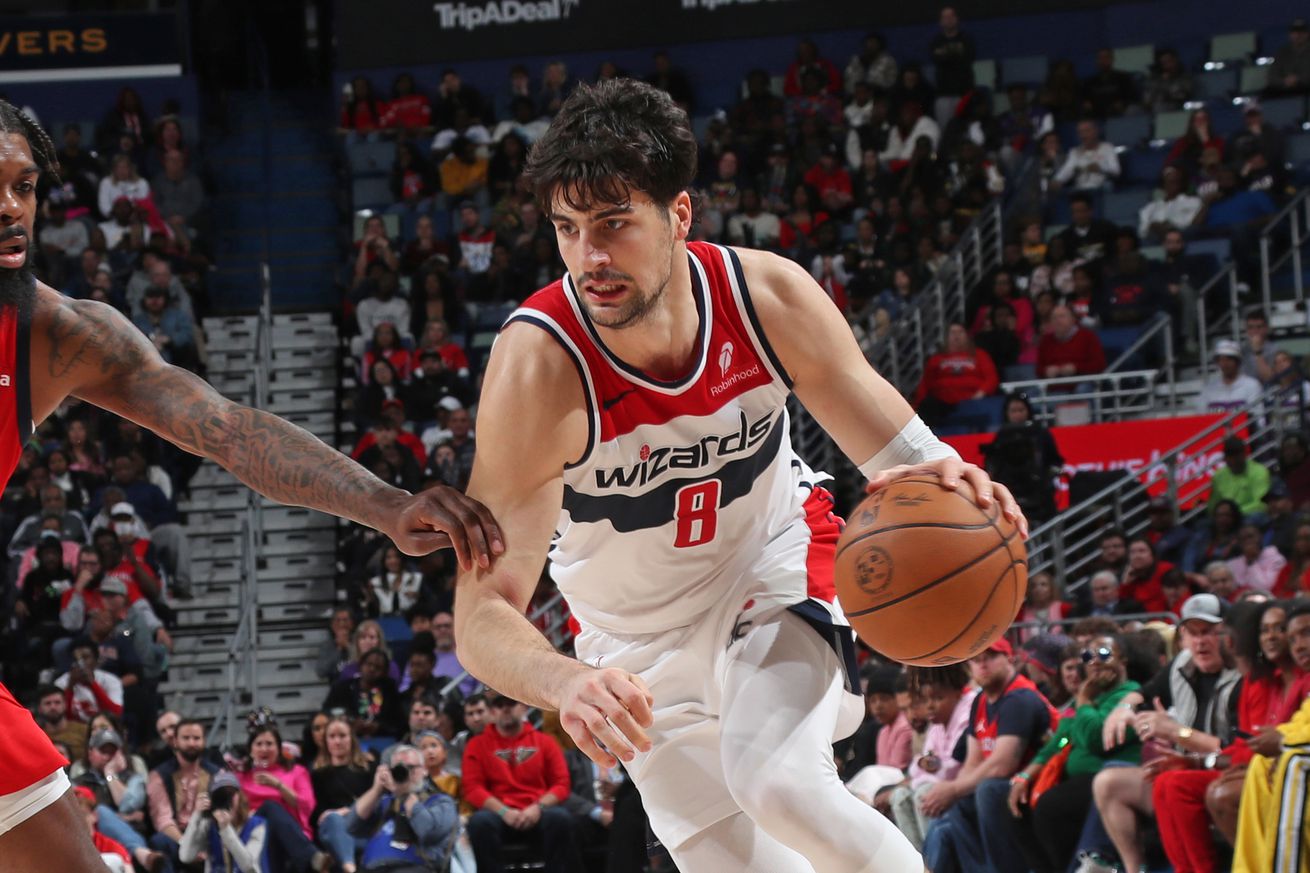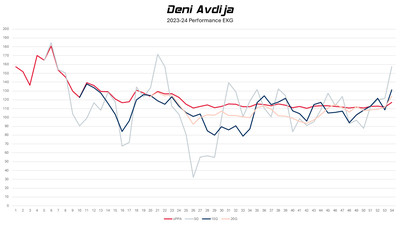
An analytical look.
The Washington Wizards hit the All-Star break with a scintillating career-high 43 points from fourth-year forward Deni Avdija. It felt like the kind of break-out game that augurs a launch into something special — even to a crusty old skeptic like me.
But, that crusty old skeptic part of my brain won’t just trust The Eye Test, and so I have to ask: Is what we’re seeing from Avdija truly a break out?
Let’s start with this: I’m comfortable saying the Valentine’s Day game was the best of Avdija’s career. He’s had two other games this season with higher PPA scores, but PPA is a per possession stat, and he sustained excellence over 40 minutes instead of 24 or 27. Those extra minutes are important.
This is the best season of Avdija’s career by a significant margin. His PPA for the season (in PPA, average is 100, 45 is replacement level, and higher is better) is at 117. His scores by season: 48, 69, 76. According to his performance EKG (see below), his score for the full season hasn’t dipped below average even for a day.

Avdija’s defensive impact has ramped back up in recent weeks, and his offensive rating (points produced per 100 possessions) sits at a career best 117 on a career high 20.0% usage rate. The work he’s put into his body and his game shows on film and in the numbers.
He’s shooting career bests on twos (56.8%) and threes (40.5%), and his free throw percentage is at his career norm. His effective field goal percentage is a career high 58.0% — well above the 54.8% league average.
This season, Avdija’s aggressiveness on the offense is palpable. His drives are up 54% on a per minute basis from last season (8.7 drives per 48 minutes in 2022-23 to 13.4 this year). This is a big part of his uptick in free throw attempts — which he’s getting at an above average rate for the first time in his career. Among rotation players, only Marvin Bagley III attempts more free throws per 100 possessions.
Avdija is above league average this season in rebounds and assists (a nice combo), and about average in steals.
In other words, Avdija’s playing the best he has since entering the NBA and pretty well overall. Classic breakout player?
Well…maybe.
Here’s the thing — some things — to consider.
Yes, his PPA is up to 117. It was 181 after the first six games of the season. It was 123 through 24 games.
His PPA over the past five games is a heady 157…a mark he’s matched through four other five-game stretches this season. His 10-game PPA is 131, which he’s surpassed twice previously this season. His PPA over the past 20 games is 124, which he’s matched or surpassed or over three 20 game spans. Basically all those were back at the beginning of the season.
There’s at least a couple ways to look at this. One is more optimistic — he started well, defenses reacted and his production drooped, and then he figured out how to counter and played better.
A more pessimistic view might be that his performance goes up and down based on how seriously opposing defenses take him and the Wizards.
I lean more towards the optimism, though there is reason to tap the brakes on anointing him a cornerstone of The New Wizards. Chief among these is his overall offensive efficiency. He’s shooting well, and his offensive rating for the season is just a hair better than league average on average usage.
But there’s more to efficiency than shooting. Anyway, through the first 21 games of the season, Avdija had a 123 offensive rating on 18.0% usage. That’s about +7 points per 100 possessions relative to average, which is outstanding.
In the 33 games since, his usage rose to 20.9%, and his efficiency dropped to 114 — -2 relative to league average. That drop in efficiency came as league average drifted up by about a point per 100 possessions. A nine-point decrease in efficiency on a three-point increase in usage warrants a caution flag.
Now, -2 efficiency relative to average on about average usage isn’t bad. He’s still adding value with that kind of efficiency. And there’s a definite bright side — the efficiency leaks (turnovers and a weak left hand) are least theoretically fixable with experience and work. He’s getting experience, and he’s a worker.
One other reason for caution: if I’d looked at the 5-, 10-, 20-, and full-season PPA numbers even one game before he torched the New Orleans Pelicans, the picture would have looked different. Here’s what his PPA scores were after game 53 (first column) and then after game 54 (second column):
- 5-game: 122 → 157
- 10-game: 108 → 131
- 20-game: 111 → 124
- Full Season: 112 → 117
In other words, that last game is doing a lot of work.
So, is he breaking out? Maybe. There are good reasons to think so beyond the kind of hope that comes from watching games while wearing Deni Goggles. His emergence as, at minimum, a viable frontcourt starter is a positive for the Wizards. He’ll need to continue improving to warrant cornerstone consideration, but he’s at a point where it’s not silly to think he’ll get there.
Player Production Average
I don’t have time for a full-scale PPA update. For those unfamiliar, PPA is my overall production metric. It rewards players for doing things that help teams win NBA games (making shots, playmaking, rebounding, defending) and dings them for things that hurt the cause of winning (missed shots, turnovers, fouls (to a point)). In PPA, 100 is average, higher is better, and replacement level is 45.
Here’s a quick list of Wizards PPA scores this season up to the All-Star break:
Starters & Rotation
- Tyus Jones → 156
- Deni Avdija → 117
- Marvin Bagley III → 109
- Kyle Kuzma → 97
- Richaun Holmes → 67
- Corey Kispert → 65
- Jordan Poole → 51
- Landry Shamet → 48
- Bilal Coulibaly → 45
Garbage Time & Fill-Ins
- Hamidou Diallo → 156
- Jared Butler → 86
- Eugene Omoruyi → 76
- Anthony Gill → 34
- Patrick Baldwin Jr. → 28
- Johnny Davis → 16
- Jules Bernard → -6
Departed
- Daniel Gafford → 155
- Ryan Rollins → 86
- Delon Wright → 77
- Danilo Gallinari → 50
- Mike Muscala → 26
- Trey Jemison → -181
